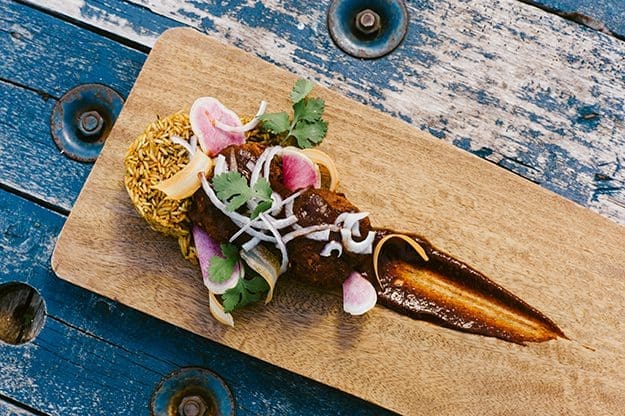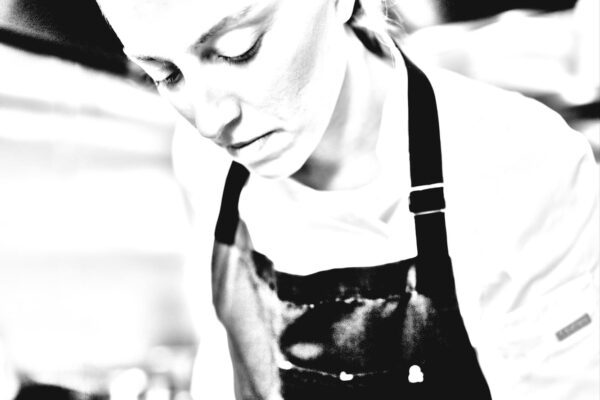Smoke & Fire

Primitive Cooking Never Tasted Better
Chef de Cuisine with Taylor Chambers
Words by Ashley Bowling Photos by Eric Morales
From dishwasher in the valley (Texas Valley that is) to Sous Chef at one of Austin’s most popular restaurants, Taylor Chambers is up and coming! EASTside Magazine spent the day with him as he shared his secrets and passion for cooking Texas Bistro cuisine.
Living and working on the east side, most nights you can find Taylor at Justine’s on East 5th. Justine’s is a “true French brasserie,” serving up old-fashioned Gallic comfort food in a lively atmosphere. On a busy evening, there are four chefs on the line serving an average of 300 guests. “It’s like a finely tuned machine,” Taylor explains. “It takes rhythm & pattern.” As the restaurant gets busier, they turn up the beats per minute. “Cooking with the team at Justine’s is a lot like playing in a band. Everybody working in perfect harmony to reach a common goal, making something beautiful, and entertaining the audience. And when the show is over, there’s a party.”
There is something about soul and passion that beautifully intertwines music and cooking. Taylor adds, “Whether at home or at work, I cannot cook without music.” As Taylor cooked for us in his home off Springdale, we listened to tunes like Sweet Little Angle by BB King and Bruce Springsteen’s I’m On Fire. The meatballs were baked in a clay roasting pot over hot coals in his backyard. Taylor reminisces as he talks about his earliest memories, “I like to cook with fire because it reminds me of my childhood. Growing up in Boy Scouts, I often built fires with my dad. The smell of the smoke is comforting to me. It’s as if the rest of the world disappears when I sit in front of a campfire.” Taylor dreams of the day when he will open his own restaurant, cooking most dishes (if not all) over an open flame.
Albondigas with Spanish Rice Pilaf
/al’ban’di’ges/ noun Small meatballs,
prepared in the Mexican, Spanish,
or South American way.
Chili Sauce
15-20 Dried Chilis
(Ancho, Chipotle, Guajillo)
1-2 t. Vinegar
Salt to taste
Fill pot with water to cover chilis. Bring to a boil, then reduce heat and cover. Let them steep for about 1 hour, covered. Remove from heat, and reserve the chili water. De-stem the chilis. Blend chilis in food processor with reserved chili water. (Caution: Do not place lid over blender if chili water is hot. Cover blender with a kitchen towel instead.) Blend to the consistency of marinara—add water as needed. Pour sauce through a strainer or sifter to remove the seeds from the sauce. Add a few teaspoons of vinegar and salt to taste.
Meatballs
The most important step in making a meatball is what’s called the “Primary Bind” when the meat and the fat, needed together make a compound structure easy enough to bind together without your typical binding agent. In other words, if you mix the meat well, you do not need a binding agent such as flour, eggs or cream. Voila! A gluten free meatball.
5 lbs. Ground Pork
(sub ground beef 85-90% lean)
1/2 c. Cilantro (chopped)
1/2 Yellow Onion (diced)
1 T. Salt
1 T. Pepper
Mix ground meat, cilantro, onion, salt, and pepper in mixer (or knead by hand). Work it until the meat mixture is tacky and sticky. This is when you know that you have established a primary bind. Form 3 oz. balls in hand. Place meatballs in skillet, cook about 2 min on each side. Searing the meat briefly achieves a browned crust to retain and develop flavor. Then place meatballs in a baking dish with lid. Cover with chili sauce. Bake in a 350 degree oven for 30-40 minutes until meatballs are cooked through.
Serve meatballs over rice pilaf and garnish with radish, red onion, cabbage, and avocado.
Spanish Rice Pilaf
2 c. Long Grain Rice
2 c. Chicken Stock
2 Garlic Cloves (finely chopped)
1/2 Yellow Onion (chopped)
2 T. Olive Oil
1/4 c. Cilantro
2 t. Tomato Paste
Salt to taste
Add olive oil and onions to skillet and cook until onions are caramelized. Add garlic and rice and continue cooking for two more minutes. Then add chicken stock, tomato paste, cilantro, and salt. Bring stock to boil. Then cover with lid and place in 350 degree oven for 20 minutes. After removing from oven, allow to set for 5 minutes before removing lid. I know. More waiting, but it’s worth it!
“Searing”
Cooking nerds refer to this as the “Maillard Reaction.” This is a complex process involving many exchanges between heat, amino acids, and various compounds within the animal protein. Wikipedia’s version: “The reactive carbonyl group of the sugar reacts with the nucleophilic amino group of the amino acid, and forms a complex mixture of poorly characterized molecules responsible for a range of odors and flavors.” Regardless of how poorly understood many of the complexities are, the basic idea is when food is applied to heat the sugars and or proteins react to the heat causing them to burn.
Contrary to popular belief, searing does not seal in meat juices. However, the flavor and textural improvement are a fine tradeoff. This is what gives caramelized onions their great flavor, and why steaks can build a crust, or why bread turns brown in the oven. Every food can go through a Millard Reaction to change or enhance its flavor.









